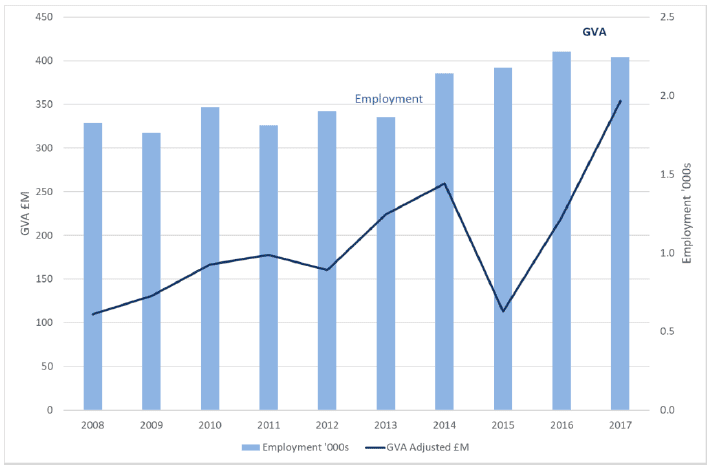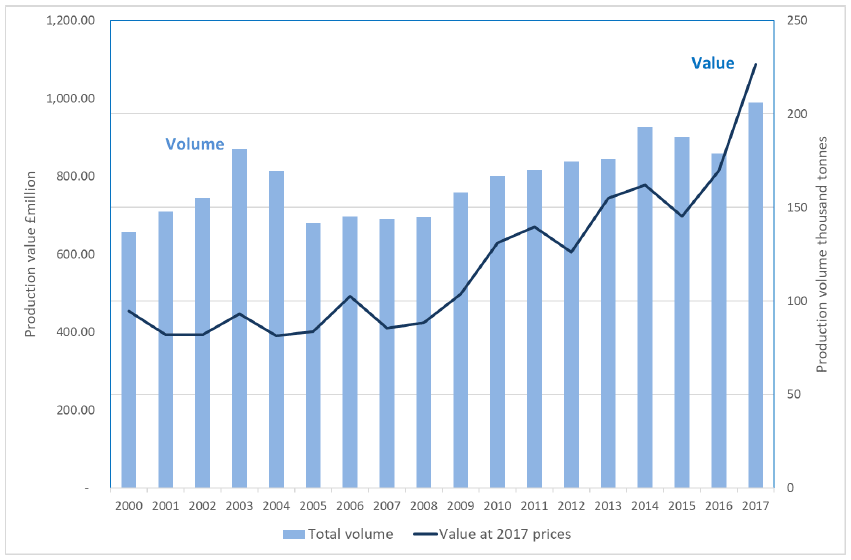Marine economic statistics 2017: corrected April 2020
Statistics on economic contributions of Scotland’s marine sectors present a time series of Gross Value Added (GVA), turnover and employment for industrial categories defined as part of the marine sector. This publication was originally published in October 2019 and was corrected in April 2020.
4. Aquaculture
4.1 Introduction
Aquaculture or fish farming is the breeding, growing and harvesting of plants and animals in water. It can take place in natural water bodies such as ponds, lakes, marshland or brackish water and the ocean. It can also be conducted in tanks, commonly found in fish hatcheries.
Aquaculture production provides a range of seafood products:
- Finfish - salmon, rainbow trout, brown trout and halibut
- Shellfish - mussels, Pacific oysters, native oysters, queen scallops and king scallops
Atlantic salmon has traditionally accounted for over 95% of the aquaculture farm gate value. The proportion for 2017 was reported at around 97%, though this may be affected by privacy issues, meaning that reporting values of other marine fin fish species discloses details of individual companies.
In this section the economic contribution of aquaculture has been estimated using two main data sources: Marine Scotland Aquaculture survey statistics for 2017 and economic data collected to meet DCF requirements. This approach allows for more reliable estimates of economic activity than SABS figures, primarily because the aquaculture survey collects data for every production site registered as active during the survey year.
The aquaculture survey statistics provide production and employment data, while the DCF survey provides financial data from a sample survey. These are combined to calculate GVA figures. It should be noted that the values reported here differ from the SABS values due to methodological differences and different data sources.
4.2 Key economic points
In 2017 aquaculture generated £354 million GVA: accounting for 0.27% of the overall Scottish economy and 7% of the marine economy GVA. The aquaculture industry provided employment for 2,200 people (headcount), contributing 0.09% of the total Scottish employment and 3% of the marine economy employment.
4.3 Aquaculture trends
From 2016 to 2017 the GVA from aquaculture (adjusted to 2017 prices) increased by 60% from £221 million to £354 million, while the longer term trend from 2008 to 2017 tripled from £110 million. From 2008 to 2017 employment increased by 23%.
The combination of rising GVA and falling employment resulted in growth of aquaculture GVA per head between 2016 and 2017, making it the highest for the marine economy.
| Year | GVA £M |
Turnover £M |
Employment Headcount 000's |
GVA Per Worker £ |
|---|---|---|---|---|
| 2008 | 110 | 424 | 1.83 | 60,234 |
| 2009 | 131 | 498 | 1.76 | 74,267 |
| 2010 | 166 | 629 | 1.92 | 86,483 |
| 2011 | 178 | 670 | 1.81 | 98,221 |
| 2012 | 160 | 606 | 1.90 | 84,378 |
| 2013 | 224 | 744 | 1.86 | 120,261 |
| 2014 | 259 | 778 | 2.14 | 121,129 |
| 2015 | 113 | 697 | 2.18 | 51,749 |
| 2016 | 221 | 814 | 2.28 | 96,797 |
| 2017 | 354 | 1,087 | 2.24 | 157,697 |
1 Figures corrected on 15th April 2020, for more information see Annex B section 17.11
In 2015, the aquaculture GVA dipped (see Figure 7) due to a combination of lower turnover and higher costs as a result of disease challenges. Since that low point, GVA from aquaculture has grown strongly, leading to a GVA of £354 million in 2017.

1 Figures corrected on 15th April 2020, for more information see Annex B section 17.11
Total aquaculture production in Scotland in 2017 reached over 200 thousand tonnes for the first time (see Table 24). The increase in volume of production and a reduction in the costs of production led to an increase in GVA. In combination with these trends, aquaculture industry figures published in 2018 (Marine Harvest's Integrated Annual Report)[6] reported that world salmon prices fell slightly from 2016 to 2017, having reached an all-time high of 6.72 euro per kg in 2016 and falling slightly to 6.31 euro per kg in 2017.
Table 24 presents more detailed aquaculture data, including aquaculture breakdown by fin fish or shellfish.
The GVA values are estimated using the volume and value of aquaculture in Figure 8. The chart shows the longer term trend in the aquaculture production.

1 Figures corrected on 15th April 2020, for more information see Annex B section 17.11
4.4 Aquaculture by geography
It is not possible to disaggregate aquaculture statistics to local authority levels as these become disclosive. In the Marine Scotland Aquaculture Production Survey Statistics Atlantic salmon and mussel production figures are presented by Scottish marine region[7] (SMR) as far as possible. However, even at SMR level some regions in Table 7 have to be merged to avoid disclosure.
Atlantic salmon production value accounts for over 95% of all aquaculture, and so the salmon figures are reasonably representative of the economic distribution of aquaculture around Scotland. Table 7 shows the distribution of Atlantic salmon production around Scotland.
| Scottish Marine Region or combination | % of Scottish value 2017 |
|---|---|
| Argyll and Clyde | 23% |
| Orkney Islands | 9% |
| Outer Hebrides | 18% |
| Shetland Isles | 21% |
| North Coast and West Highlands | 29% |
Mussel production mostly occurs in the Shetland Isles, accounting for three quarters of all Scottish production. Oyster production is largely split between the North Coast group and Argyll and Clyde.
Table 25 and Table 26 present a time series of salmon and mussel production by region.
Contact
Email: Venetia.Haynes@gov.scot
There is a problem
Thanks for your feedback